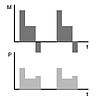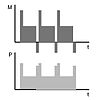Nominal operating mode

A rated operating mode is a description of the stress on an electrical machine . It defines how long a machine or device may be operated and whether and how long a break must be made, for example to protect it from overheating.
purpose
Because it would be uneconomical to design all machines for every conceivable difficult task, nominal operating modes were defined in order to be able to clearly identify both suitability for difficult conditions and a restriction to particularly easy tasks.
For example, the requirements for motors in elevator systems and escalators differ fundamentally. While the former have to start up again and again under heavy loads, the latter are usually started up without any significant load. The requirements can be even lower if machines are switched off regularly and then allowed to cool down.
definition
The nominal operating modes are defined in the international standard IEC 60034-1, which corresponds to the European standard EN 60034-1 and various national standards.
If no nominal operating mode is specified on the nameplate of a machine, it is designed for continuous operation with constant load. In addition to any other rated operating mode, additional information such as the number of switching cycles per hour and the duty cycle are required to be able to assess the suitability of a machine for an application. If only the duty cycle is specified in addition to the nominal operating mode, the cycle time is 10 minutes.
Nominal operating modes
| Abbreviation | description | M / P diagram | necessary additional information |
|---|---|---|---|
| S1 | Continuous operation with constant load |

|
|
| S2 | Short-term operation |

|
|
| S3 | Periodic intermittent operation |

|
|
| S4 | Periodic intermittent operation with the influence of the start-up process |

|
|
| S5 | Periodic intermittent operation with the influence of the start-up process and electrical braking |

|
|
| S6 | Uninterrupted periodic operation |

|
|
| S7 | Uninterrupted periodic operation with electric braking |

|
|
| S8 | Uninterrupted periodic operation with load and speed changes |

|
|
| S9 | Operation with non-periodic load and speed changes |

|
|
| S10 | Operation with single constant loads |
Examples
With an electric winch , the motor is exposed to heavy loads. In order to protect it from overheating, cheap devices are often only approved for the rated operating mode S3 25% . This means that it may only be operated for 2.5 minutes in a period of 10 minutes and must cool down again for the remaining 7.5 minutes (at an ambient temperature of 20 ° C). Often, the shutdown with respect to warming takes place automatically via a thermal circuit breaker , which stops operation until the machine has cooled down.
A crane or helicopter winch, on the other hand, is designed for continuous operation S1 and is correspondingly expensive.
A kitchen mixer , for example, may only be operated for 10 minutes. This corresponds to the rated operational class S2 .
literature
- Rotating electrical machines - Part 1: Rating and performance (IEC 60034-1: 2004); German version EN 60034-1: 2004 , 3rd edition VDE 0530-1, VDE Verlag, Berlin, 2005
- Gregor D. Häberle, Heinz O. Häberle: Transformers and electrical machines in power engineering systems. 2nd edition, Verlag Europa-Lehrmittel, Haan-Gruiten, 1990, ISBN 3-8085-5002-3
- Günter Springer: Expertise in electrical engineering. 18th edition, Verlag Europa-Lehrmittel, Wuppertal, 1989, ISBN 3-8085-3018-9